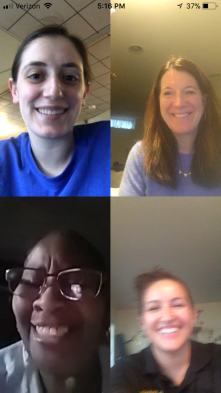During Uncertain Times, Widener Clinics Continue to Serve

Unpredictable circumstances created by the Coronavirus pandemic have placed roadblocks in aspects of daily life, including access to health care and other services. Despite these trying circumstances, Widener’s clinics and centers remain committed to serving their constituents.
In the Chester Community Clinic, members of the clinic’s student board collaborated with faculty to identify the options and obstacles involved in delivering care to clients safely and securely.
We started exploring telehealth options. Clients still needed care and services and we needed to figure out how to give them that. —John Vizzini '21, graduate physical therapy
This transition helped a number of clients, including Bridgette Staples who turned to the clinic after suffering
a stroke in 2019.
Fortunately for Staples and other clients, the new telehealth system allowed her to continue care remotely.
Students and faculty in the Widener Child Therapy Clinic (WCTC) followed a similar protocol.
Jessa Cooperman, a first-year clinical psychology doctoral student completing a practicum in the WCTC, transitioned her clients to virtual sessions in the spring. Continuity of service, she said, is critical given the pandemic’s impact on mental health.
“A lot of our work has switched to help parents build structure and schedules. How do we help you support your kids? And telehealth allows us to maintain our rapport with families,” said Cooperman.
A first-time telehealth provider, Cooperman said for her clients the remote delivery “became the new normal pretty quickly.”
Modern telehealth practices date back to the 1920s when the practice first appeared in academic publications. The ability to connect digitally enables care providers to continue treatment plans from a distance as well as reach more patients.
But as Cooperman explains, the move to online is not a cure-all.
There are a lot of barriers people face in accessing services. You would think they would all be fixed to have this right in the home. But a lot of people still face barriers, including unreliable work shifts and internet access. Jessa Cooperman '24, clinical psychology
Despite some limitations, remote delivery enables the university’s clinics and centers to continue to meet the needs of their constituents.
In March, the Small Business Development Center (SBDC) moved its operations online to maintain consulting sessions for clients and local small businesses. With assistance from students in the School of Business Administration, the SBDC developed and launched a three-part webinar series to help small business owners navigate the pandemic’s impact.
The Widener Community Nursing Clinic, led in partnership with CityTeam, stayed connected with patients via telemedicine services by phone. This move allowed the nationally-recognized clinic to remain a vital service in the community, equipped to dispense health care management, advice, and prescription refills.
Nursing also plans to incorporate the use of telehealth into course programming with the assistance of a recent financial gift.
The gift was made by alumnus Tom Bown and his wife Bonnie. Bown, who served on the Board of Trustees for 20 years and remains an honorary member, says that the “goal was to do something in the COVID climate to acknowledge the nurses that were doing so much for the country and to give future nurses the tools they need to be leaders in the field.”
Adding components of telehealth into class lessons “will help assure that our undergraduate and graduate students are well prepared to use telehealth according to the evidence for best practice and up-to date technologies,” said Mary Powell, assistant dean of nursing.
In addition to uninterrupted health care and services, the move to telehealth offered experiential learning opportunities for students to practice patient care from a distance.
For graduate physical therapy student John Nellett, no physical interaction with a client meant clear communication was imperative. According to Nellett, the online setting taught him “to use the right language to explain things in a way that allowed clients to learn safely, that didn’t require a touch or visual cue.”
That approach proved tremendously effective for Staples, who says her virtual sessions met the same caliber as in person.
“They worked me just as well online as they did in the clinic,” said Staples.
After weeks of video therapy sessions, Staples proudly boasts the milestones she has reached in her recovery. She credits her newfound strength and confidence to the steadfast care she received from student-therapists.
“They’ve been such a big help to me,” Staples said.
Explore Widener's Centers & Clinics



